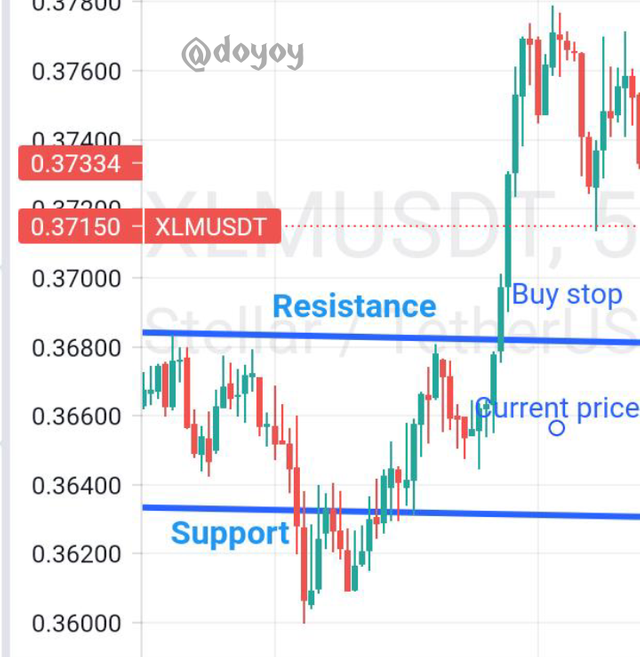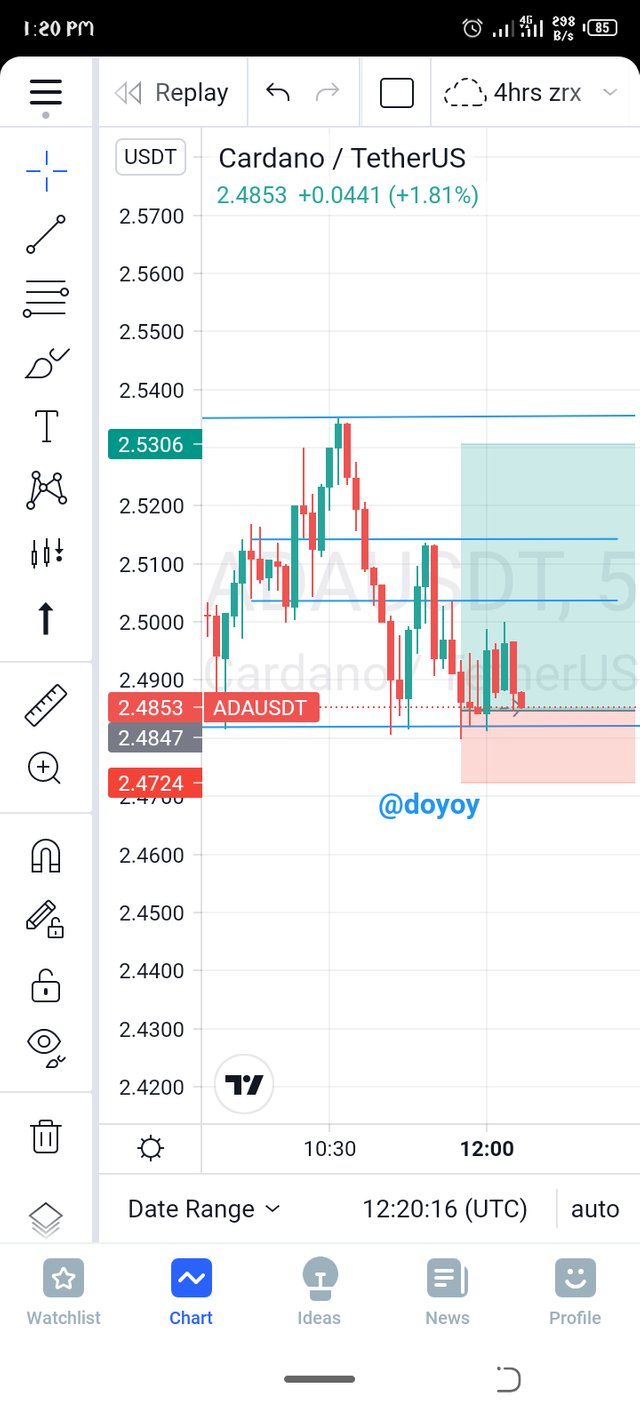We will be explaining some of the trading terminologies that we can come across or must have come across during our journey in trading.
Below are some of the terminologies
. BUY STOP:
Buy stop is a type of order that is placed above the current market price of an asset which will then be executed automatically by the system whenever the price gets to the point set by the trader. This can only be set whenever a trader feels the price will get to a certain level or it will break out from the level at which it is currently.
Using the XLM as an example.

The resistance for the asset XLM was at $0.36800 for some period of time the price has been getting rejected at that point for some time, and the support was at $0.36400 before the price broke the support level and fell to $0.36000 twice before going over support line again this is a good sign that the price will definitely keep up with it's uptrend and possibly break out from the resistance, after analysis the trader who believe there will be a break out and doesn't want to miss out will then set his buy stop above the resistance price of $0.36800 he will set the buy stop at $0.3700 so he can benefit from the profit of the breakout. This helps a trader not to miss out from the breakout incase of non availability during the time.
SELL STOP:
This is the opposite of the buy stop where an order is placed below the current market price of an asset to other stop one from incurring much loss or to enable one take profit for those who trades futures and are willing to go short.

Using ETH as example let's. Say the price of ETH was at $3060 and a trader analysis shows that the price will be going down further, the trader then set his or her sell stop at $3020 the price will then be triggered at that price to go short for futures.
BUY LIMIT:
Buy limit is a type of order that enables a trader to buy an asset at his own convenient price. The trader gets to set the price that he or she wants and this order isn't executed immediately until the market price gets to the price set by the trader. So.until the market price gets to the desired price it won't execute.

For example if a trader wants to buy BNB and he wants to buy at the price $400 but the price is currently at $428 he can set a buy limit at $400 and set the amount he wishes to buy at the price. Once the market price gets to the level it execute.
SELL LIMIT:
This is the opposite of the buy limit. This is an order that enables a trader to sell his or her asset at a price that he or she wishes to. The order will also not execute immediately until the market price gets to the price.

Let's say I bought BNB when it was $400 and I intend to sell at $450 I will just set my sell limit to $450 and input the amount I wish to sell at that price, the order will be there until the price get to the price I set and it will then execute.
TRAILING STOP:
Trailing stop is another order type that allows a trader to set a pre order at some percentage away from the market price.
This helps traders lock in their profit by making the trade remain open and the trader continues to profit from the trade if it keeps going in his or her set direction. When the price moves in an opposite direction by a certain percent as set by the trader the t railing stop order will be executed at the current market price.

It uses a callback rate, so for example if I go long on an asset which is at $90 with a callback rate of 5% and the asset price keeps going up and it gets to $100 if the price comes down to $95 the order will automatically close and lock in my profit of $5.
MARGIN CALL:
This is like a call to order given to an investor during trade by the broker which the investor is using. This simply means the risk level to liquidation is too high and the trader must either close the trade and accept the loss or add more asset into his or her account so as to reduce the risk of liquidation.
If the investor doesn't do any of this,the investor is liquidated and the trade is closed on behalf of the investor. This is why a good risk management is good while trading.
RISK MANAGEMENT
It is important for traders to know that it is not everyday winning while trading and so they should have set out a plan to reduce the rate at which they loose their money or find a strategy to minimize their loss this strategy is known as risk management.
Risk management is a strategy or technique that a trader use to protect themselves from blowing their account or loosing huge amount of money because the market turned against them. Not trading at all is a more better risk management than entering a trade with zero risk management. Not loosing your hard earned money is also profit for you, traders should note this.
There are some common rule that helps in managing risk in trading which are
REWARD RATIO.
Reward ratio is a method in which a trader sets the amount he is willing to loose and sets the amount of profit he wishes to get from the trade. The reward ratio can be 1:2 or 1:3 depending on the trader. This means that for every $1 a trader invest he will use it to get $2 or $3 and if the market turns around he looses just $1.
Percentage Rule
Another strategy is the percentage Rule where a trader risk just a certain percentage of all his portfolio while trading, this can be 2% or 1%. So when a trader portfolio is $1000 for every trade he takes he use just $10 if he uses the 1% rule and $20 if he uses 2% rule.
Another one is ensuring not to open multiple trade at a time because of greed, this could turn around and boomerang which will cause alot of loss for the trader.
Setting Stop loss and Take profit.
This is another risk management where a trader sets his or her stop loss some pips below the entry price so as not to incur much loss if the trade decide to go against the trader and also setting take profit at intervals not being too greedy.

Using ADA as illustration, after locating my support and resistance as this is one of my strategy I noticed the price has just gotten to the support level and is set for reversal. My stop loss is set at some pips away from the support level which is reading a 0.50% loss on and my take profit are set at intervals at some points.
This way if the price doesn't get to the resistance level I will have taken profits all the same and if the price reverses and goes against me I would not incur much lost.
USING THE MOVING AVERAGE STRATEGY
I will be using the moving average strategy to show that I understand the risk management strategy. Firstly we go to our analysis platform which is binance and select the asset we want to trade.
We then select the moving average on the indicator menu by clicking on indicator button MA shown below the screen, the moving average is added on the chart.

After then we try to locate a good entry point on the chart either a golden cross or a death cross. Using the TLM chart we can see that there was a golden cross and that will be our entry point.
The stop loss will be set below the line drawn as a support line and the take take final take profit will be at the last resistance level. Like the risk management strategy, multiple take profits has been set and a reward ratio has also been set.
Hi
Thanks for participating in the Steemit Crypto Academy
Feedback
This is good content. Well done with your practical study on Risk management.
Downvoting a post can decrease pending rewards and make it less visible. Common reasons:
Submit